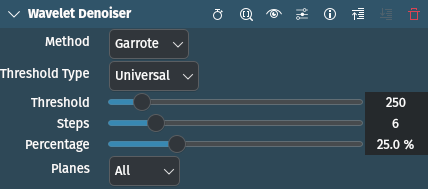Wavelet Denoiser¶

Description
Wavelet[1] based denoiser. It transforms each frame from the video input into the wavelet domain, using Cohen-Daubechies-Feauveau 9/7[2]. Then it applies some filtering to the obtained coefficients. It does an inverse wavelet transform after. Due to wavelet properties, it should give a nice smoothed result and reduced noise without blurring picture features.
Atenció
The effect works best with smaller threshold values. It is easy to over-filter this effect.
Nota
Using different planes and/or higher threshold values can be used for artistic manipulation of the image.
Parameters
Parameter |
Value |
Description |
|---|---|---|
Method |
Selection |
The filtering method the filter will use. See below. |
Threshold Type |
Selection |
The threshold type the filter will use. See below. |
Threshold |
Integer |
The filtering strength. The higher, the more filtered the video will be. Hard thresholding can use a higher threshold than soft thresholding before the video looks overfiltered. |
Steps |
Integer |
Number of times the wavelet will decompose the picture. Picture cannot be decomposed beyond a particular point (typically, 8 for a 640x480 frame - as 2^9 = 512 > 480). |
Percentage |
Percent |
Partial of full denoising (limited coefficients shrinking) |
Planes |
Selection |
Select the planes to process. See below. |
The following selection items are available:
Method
Soft |
All values under the threshold will be zeroed. All values above will be reduced by the threshold. |
Hard |
All values under the threshold will be zeroed |
Garrote |
Scales or nullifies coefficients - intermediary between (more) soft and (less) hard thresholding (default) |
Threshold Type
Universal |
Threshold used is same for all decompositions (default) |
Bayes |
Threshold used depends also on each decomposition coefficients |
Planes
None |
|
Y (Luminance) |
|
U (Chroma red-diff) |
|
YU |
|
V (Chroma blue-diff) |
|
YV |
|
UV |
|
All |
Default |
Alpha |